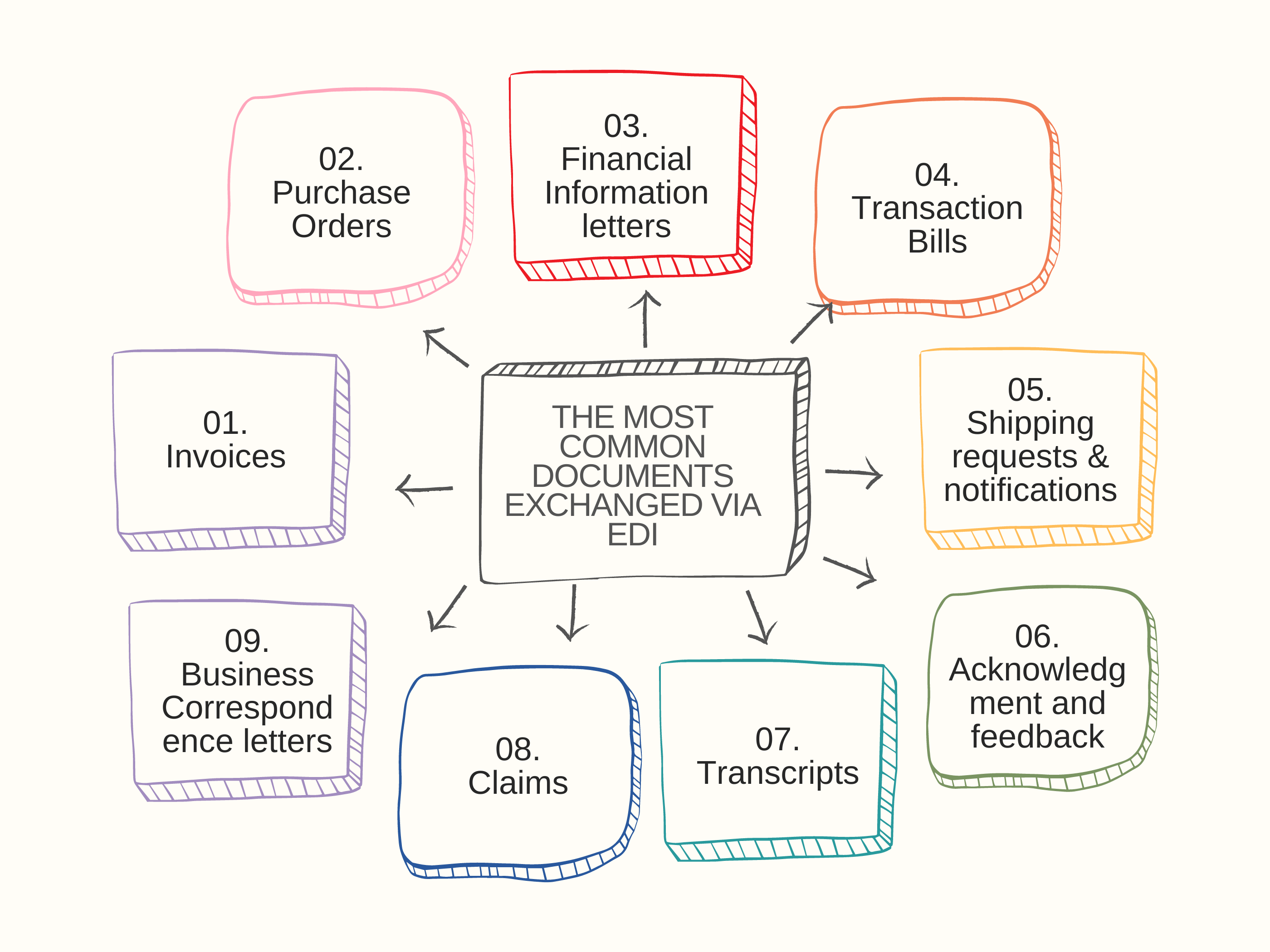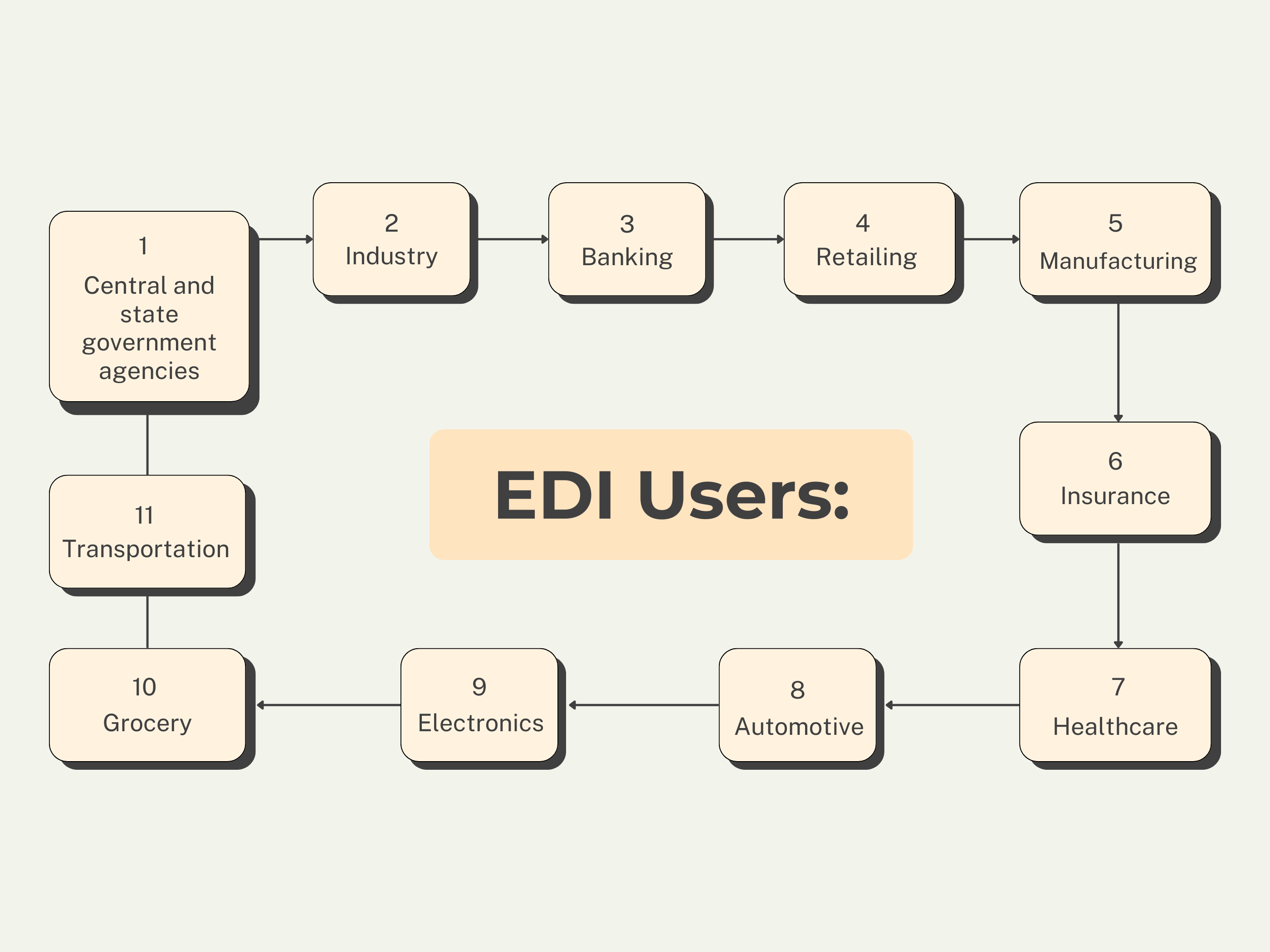Table of Contents
Electronic Data Interchange is a process that permits organizations to exchange files and information electronically. This process works with the aid of replacing paper-based total conversations with electronic documents. It is a steady platform that could provide advantages consisting of stepped-forward accuracy, greater velocity, and financial savings. Before EDI integration, agencies should first investigate the compatibility of their current systems. Also, discover the form of information that is to be exchanged. The organization must additionally make certain that the EDI era meets its needs.
Once these steps have been completed, organizations want to implement a secure infrastructure for exchanging files, together with FTP or SFTP servers. Organizations also need to define the guidelines for fact-checking and ensure that everyone involved in the procedure has access to the important software program.
- The Definition of EDI Integration
Electronic Data Interchange integration is an era that facilitates the exchange of business enterprise documents among organizations. It allows an employer to acquire and send a whole lot of files, which include buy orders, invoices, and shipping notices, in an electronic format.
Instead of using traditional paper-based total strategies for changing facts, EDI-integrated business solutions make use of digital communication and automatic enterprise methods to facilitate speedy and steady transactions. The use of EDI solutions and integration can help agencies improve factual accuracy, streamline their operations, reduce prices, and offer higher customer support.
- Importance of EDI Integration in Business Operations
- Streamlined Data Transfer: EDI integration provides agencies with a standardized and streamlined process of shifting data between trading companions, which reduces guide approaches and eliminates the need for paper-primarily based transactions.
- Greater Efficiency: By integrating EDI, organizations are capable of automating fact switches amongst their systems, lessening errors, and speeding up conversation and transactions.
- Improved Accuracy: EDI integration ensures that records are exchanged in a consistent and correct process, eliminating manual mistakes that could occur with paper-based techniques.
- Lower Costs: EDI eliminates the need for manual work, which results in decreased charges for organizations in addition to their customers.
- Increased Security: Data exchanged via EDI is included with the aid of encryption and exclusive safety protocols, making it more secure than paper-based total processes.
How EDI Integration Works
- Establishing the Connection: EDI integration calls for the two systems to communicate with every different being related to every exception in a solid way. This connection is usually set up via a Virtual Private Network (VPN). It presents the essential safety for facts transfer between the two structures.
- Mapping Data Fields: The subsequent step is to map out the various data fields so one can be exchanged among the two systems. This consists of figuring out the perfect data with the motive to be transferred and ensuring that it is properly formatted for every tool.
- Data Validation: After mapping out the information fields, the two systems need to make certain that each information being transferred is accurate, whole, and legitimate. This validation machine includes checking for any errors or inconsistencies in the records in advance of the miles sent to its excursion spot.
- Data Transfer: Once the information has been established, its miles are then geared up to be transferred between the two structures. This switch is commonly completed via a stable digital channel, together with an FTP server or a constant email system.
- Monitoring and Troubleshooting: The last step includes retaining music and resolving any problems that would arise for the duration of anything of the EDI provider. This consists of analyzing all information in the event of inconsistencies or mistakes and troubleshooting the technical troubles that could stand up at some point in the machine of integration.

Explanation of the process behind EDI Integration
EDI (Electronic Data Interchange) integration is a process of changing data between two or more agencies in a standardized format. EDI is a digital alternative to standard paper-based strategies, including mail, fax, and smartphone.
The era of EDI integration is based totally on well-known XML (extensible Markup Language) and web service formats that enable businesses to change facts with each special in a solid and inexperienced way. Organizations must make sure that the configuration of their EDI integration platform is up to date in a way to holds compatibility among structures. This calls for the usage of a strong connection together with a Virtual Private Network (VPN) to defend the data exchange.
Additionally, the mapping of facts fields must be simply efficient so that diagnosis of any error is easy. The data are then shown for accuracy earlier than being dispatched to their vacation spot, discovered with the aid of a process of monitoring and troubleshooting any problems that upward push up inside the route of the EDI integration.
Steps Involved in the EDI Integration System
Understanding EDI
- Analyze business enterprise desires and goals
- Understand information and switch requirements
- Establish the alternate protocol for use for EDI integration
Set up EDI System
- Install crucial hardware and software program additives
- Design the interpretation maps and correct judgment in an extremely good process for us to method incoming messages
Exchange Data
- Establish stable connections between buying and promoting partners
- Exchange data files securely the use of the protocol installed for EDI integration
- Track and display screen the exchange of data for accuracy and consistency
Monitor and Troubleshoot
- Monitor the data for any mistakes or inconsistencies.
- Troubleshoot and remedy any troubles that get up at a few degrees in the EDI integration technique
Benefits of EDI Integration
- Increased Efficiency: EDI integration can assist in streamlining data exchange among organizations, eliminating the want for guide entry and reducing the threat of mistakes from rekeying records. This allows us to make sure that each stakeholder has entry to accurate data in a well-timed process.
- Improved Customer Relationships: Integrating EDI can help improve patron relationships by using a process of improving accuracy and communication. By automating the alternation of facts between businesses, customers can enjoy faster turnaround times and fewer mistakes within the process. EDI can also assist create a better patron amusement using providing extra well-timed admission to important information.
- Cost Savings: EDI integration can help organizations shop cash using lowering or doing away with pricey paper-based transactions and the associated hard work fees. Additionally, EDI services substantially reduce the need for manual data access processes, which can be time-consuming and pricey. By automating the records alternate method, companies can reduce their overhead charges and improve their backside line.
- Improved Data Quality: EDI integration can help improve the first-rate of facts being exchanged among agencies. By the usage of a standardized format for changing information, organizations can ensure that the facts they’re sending and receiving are accurate and regular. This allows for lessening errors and makes it less difficult to research facts across unique structures.
- Streamlined Business Processes: EDI integration can assist in streamlining business techniques with the aid of reducing guide access and increasing the accuracy of records exchanges. This eliminates the need to manually enter and re-input facts, permitting organizations to the consciousness of extra critical duties. Furthermore, EDI integration can lessen office work and the related costs of printing, submitting, storing, and delivering files.
Key Components of EDI Integration
- System Connectivity: This is the muse of EDI integration, and it involves organizing a connection among systems. A third-party provider company can complete this by using direct connections inclusive of FTP, AS2, OFTP2, or VANs.
- Document Formats: The document format will dictate how the information is established and formatted whilst its miles are transferred among structures. This consists of the sort of records that require exchange, in addition to any particular format or requirements that must accompany to make sure compatibility between the 2 systems.
- Translation Software: Translation software is used to transform files from one format to some other, permitting specific organizations the use of different systems to change information. This software program is also of use to test accuracy and completeness, ensuring that the exchange of records is effective.
- Security: Security is a crucial aspect of EDI integration as it guarantees that data remains confidential and stable all through transmission. This consists of security measures like encryption, authentication, and digital signature verification.
- Monitoring and Support: EDI integration calls for ongoing tracking and help to make certain the gadget is operating properly and that any potential troubles are recognized and addressed quickly. This consists of monitoring data best, ensuring machine compatibility, and troubleshooting any errors that could stand up.

Common Challenges in EDI Integration
- Dealing with Different EDI Standards: Given the multitude of different EDI standards (ANSI X12, EDIFACT, XML, and so forth.), it can be a mission to make certain proper information translations between systems. This calls for expertise in every fashionable’s particular technical necessities and capability.
- Ensuring Data Accuracy and Completeness: Data accuracy and completeness are vital for EDI integration to be successful. This requires validating records on both facets of the relationship, in addition to making sure that each necessary data is there in every record.
- Security: The protection of EDI documents is paramount, as any breach could result in touchy records being leaked. This calls for imposing strong safety features consisting of encryption, authentication, and virtual signature verification.
- Document Management: EDI files must be managed effectively to make certain that data stays modern-day and up-to-date.
- Compliance: Companies need to adhere to all relevant industry policies whilst moving data electronically, which can be an undertaking. This calls for staying updated on changes to guidelines and making sure that systems are compliant with modern-day requirements
- Troubleshooting: To ensure dependable EDI integration, issues should be diagnosed and resolved quickly. This requires monitoring the system for any mistakes and right away addressing them once they stand up. Additionally, perform regular testing of the system to ensure it is functioning properly.
- Support: Regular guidance is important to preserve successful EDI-managed services. This includes offering technical help to users, responding to inquiries in a well-timed process, and staying abreast of present-day enterprise traits.
Seamless Data Integration
Choose our EDI experts today
Best Practices for Successful EDI Integration
- Secure your EDI Infrastructure:
Ensure that all sensitive information is steady and guarded against unauthorized admission. Utilize excellent practices such as firewalls, encryption, and other security protocols for data security.
- Establish an EDI Partner Network:
Identify the agencies from which you’ll be exchanging data and create a community of trading partners who have like-minded structures and report formats.
- Validate EDI Documents:
Ensure that incoming documents are correct and complete by validating them in opposition to a predetermined set of regulations. This consists of checking for accuracy, completeness, record kinds, and every other important criterion.
- Automate the Exchange Process:
Implement automated tactics to streamline the trade of information between systems. This consists of scheduling information transfers, putting in place signals while transfers fail, and automating the interpretation of files among exclusive formats.
- Monitor Exchanges:
Monitor exchanges to make sure they may be a hit and that no errors arise at some stage in transmission. EDI solution providers consist of regularly check high-quality information, check for gadget compatibility, and troubleshoot any mistakes that could arise.
- Invest in Training:
Provide a body of workers with the EDI training they want to use the EDI system and troubleshoot any problems that could arise. This consists of understanding the basics of facts change and how to use the software, in addition to studying approximately EDI standards and pleasant practices.
- Monitor Performance:
Monitor overall performance to make sure that everyone additive of the EDI system is operating efficiently and meeting turnaround times. This includes regularly checking data accuracy rates, making sure compliance with regulatory requirements, and tracking mistakes.
- Establish a Quality Assurance Process:
Develop a process regularly to take a look at the accuracy and completeness of exchanged data and documents. This consists of setting up approaches to identify errors, making certain records correct and whole, and music any issues that arise.
- Implement Change Management:
Having a machine in place for handling modifications to EDI service providers is crucial for successful integration.
- Optimize the System:
Continuously check and enhance EDI system performance to make certain that it is strolling efficiently. This consists of tracking document processing instances, making sure information is accurate, and making any essential modifications to optimize the device.
- Implement Quality Control Measures:
Develop fixed or best-managed measures for incoming records to reduce the chance of errors. As a result, it includes validating a predetermined data format or utilizing double-access verification.
- Track & Analyze Data:
Monitor the performance regularly and utilize data analytics to pinpoint any areas where you could improve. Use metrics like the time to turnaround, process accuracy of data, and conformance to regulations to measure the effectiveness of the system.
Take Control of Your Data Flow and Optimize Operations With EDI Integration Services
Real-Life Examples of Successful EDI Integration
EDI is a method that allows the speedy and steady exchange of enterprise files between different agencies. EDI integration facilitates streamlining the float of data, allowing groups to process transactions more successfully at the same time as decreasing guide processing. This era has been confirmed to be an invaluable tool for plenty of groups, and there are numerous top EDI providers examples in the real international.
Amazon:
Implementation of EDI in ASN (Advance Shipping Notice) by Amazon. By the use of EDI, Amazon was capable of gaining access to actual-time cargo facts, streamlining their tracking method. Also, lowering guide office work. Walmart is another instance of a business enterprise that has implemented EDI.
Walmart:
Walmart’s EDI device allows them to easily acquire purchase orders, invoices, and transport facts from their providers in a well-timed fashion. This helps Walmart make sure they have the stock available when customers want it. And also, decrease expensive mistakes associated with guide processing.
UPS:
UPS is but every other example of a successful EDI integration. It makes use of EDI to automate its delivery techniques, allowing clients to obtain up-to-date monitoring data and shipment statuses.
Target:
Target is another company that carried out EDI integration to streamline its ordering technique. By integrating EDI support services, Target changed into being able to receive buy orders greater, speedy, and more accurately from providers, permitting them to manage stock ranges and hold clients happy with timely deliveries. As a result, Target became capable of reducing costs associated with guide facts entry. Also, it put off the need for paper-primarily based purchasing orders.
Costco Wholesale:
They have also applied EDI to enhance order accuracy and decrease human mistakes in the processing of orders. By leveraging EDI, Costco became capable of ensuring that customers received their orders fast and accurately. Furthermore, by automating its ordering process, Costco was able to lessen the fees and improve consumer enjoyment.
These are only a few examples of successful EDI integration in the real world. Companies keep utilizing EDI for faster transaction processing, advanced accuracy, higher data safety, and improved customer service. EDI is an important era for companies looking to remain aggressive in these days’ virtual market.
Lessons and key takeaways from the above examples
- Organize with a detailed plan and timeline before beginning any mission.
- Make sure to have sufficient sources, both human and monetary, to complete the mission correctly.
- Take time to investigate the equipment and methods for completing the task at hand.
- Don’t be afraid to ask questions or seek help from professionals if you need it.
- Utilize EDI systems to streamline tactics and reduce manual data entry charges.
- Utilize EDI to improve communication between organizations and reduce mistakes in data processing.
- Pay close attention to security features when integrating EDI structures, as it involves the exchange of sensitive information.
- Take advantage of the latest technology, which includes cloud-based integration techniques, to ensure the best performance.
- Monitor the overall performance of EDI systems to make sure they are running easily.
Trust Our Comprehensive EDI Services for Data Integration
Conclusion
EDI integration and its essence in business is that it’s far a useful device for businesses of all sizes. It offers a steady, reliable, and value-powerful way to trade information between groups.
EDI integration helps automate approaches along with ordering, invoicing, purchasing, transporting, and receiving items and bills. This gets rid of guide mistakes and improves accuracy. By automating those strategies, organizations can lower prices and enhance efficiency.
Moreover, EDI integration enables companies to comply with regulatory requirements and change information in a standardized layout. Organizations must apprehend the advantages of EDI integration to be able to leverage its blessings.
- Encouragement for businesses to explore and implement EDI Integration for improved operations and competitiveness.
As the global business landscape evolves and becomes more virtual, organizations need to live aggressively by utilizing new technology. One of the high-quality ways to do that is to explore and implement EDI integration.
EDI is an era that enables agencies to change facts electronically. As a way to automate methods, reduce prices, and enhance operations.
Businesses need to also be privy to any compliance necessities and regulations regarding the usage of EDI generation.
Overall, EDI integration is a useful tool for organizations of all sizes. It can greatly improve performance and decrease fees at the same time also supporting agencies to observe regulatory necessities.






